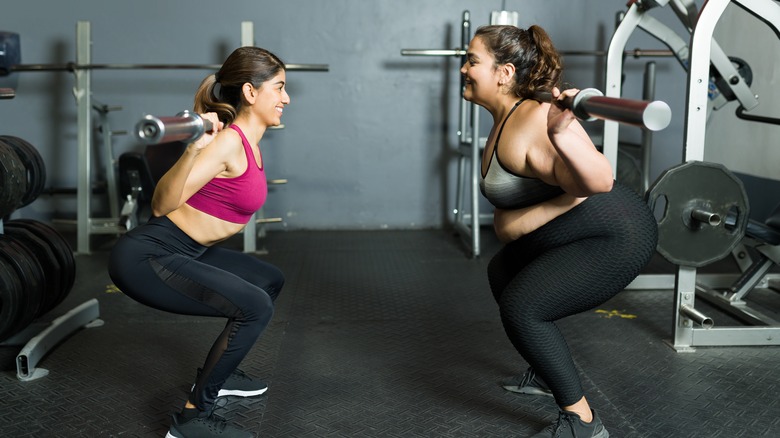5 Signs You Can Rank Up To Heavier Weights At The Gym
For most people, the point of working out is to improve. We work out to improve how we feel mentally and physically. Whether we are focused on cardio or strength training, staying stagnant in our workouts is something that trainers discourage. When we enter the gym, we should be pushing ourselves harder each time. While this is easier said than done, there is perhaps no easier way to measure our progress than in strength training. Most trainers will tell you that your goal while working out should be a sort of progressive overload. Progressive overload is the act of increasing the intensity of your workouts each time whether that's running faster for longer or pushing yourself to lift heavier weights (via Medical News Today).
Because progressive overload is the goal of many, it can be hard to know just when to increase your weights while strength training. If you are wondering when to start pushing yourself a bit more, pay attention to the signs your body is giving you throughout your time in the gym.
You can get through all of your reps easily
If you find you are getting a little too comfortable with your workouts and can get through your repetitions without breaking a sweat, you may need to move up to heavier weights. According to Self, you'll know when to move up in weight when the last few reps aren't challenging anymore. If you add more weight, finish as many sets as you can with proper form with the new weight. Then, go back to your previous weight to finish your sets.
When you do add weights, fitness experts warn against adding too much at once. No more than a 10% increase in weight is ideal for those who are looking for a new challenge. As you add weight, you should find it difficult to get through as many reps as you have at the previous weight. Don't get discouraged. This is exactly the challenge that will help you gain muscle and burn fat.
You never get sore or fatigued
If you get sore after a workout, it might be a good sign. Muscle soreness is actually an indication that your muscles are growing. According to Houston Methodist, this soreness is a characteristic of microtears which activate inflammatory responses that your body produces to heal it. If your body never gives you any signs that a workout has occurred, it may have been too easy for you. When you are looking for muscle soreness as a sign that you've pushed the limits of your comfort zone, it will be pain that lasts for a day or two after the workout but isn't so much that you cannot complete your day-to-day tasks. Fatigue is a good sign that you have pushed yourself, and this kind of soreness should leave you energized more than exhausted (via Hopkins Medicine).
If you do feel sore after adding more weight at the gym, take about 15 minutes for some static stretching to ease the pain that challenging yourself can bring. Your muscle pain should lessen each time you stretch, and you'll be back to strength training pain-free in no time. If your pain lingers or is more severe, you may need to see your doctor. Being sore is a normal experience for muscle growth, but it should never be so severe that you cannot complete your day normally.
You zone out during your sets
We all know how important it is to stay present and aware when we are operating fitness machines or heavy weights. Not doing so can put you or those working out with you in danger. That's why zoning out while you work out is such a problem. In fact, it may be a sign that you need to intensify your workout. If you are bored or complacent with your routine at the gym, chances are you are not putting in the effort needed to improve physically.
No matter what you are trying to accomplish, you've got to have a specific and measurable goal in mind in order to feel like you are improving. Sublime Reflection recommends taking the time to set some strength goals. You should even go so far as to write them down. Having a goal you're striving for can get you out of complacency and help you set ways to measure success.
You're not progressing
Most of us agree that the whole point of working out is to create a stronger version of ourselves. If you've been lifting the same weights for the same amount of reps for a while now, it's likely that you are not seeing the results you'd like. Experience Life says that although it seems obvious, it's not something many notice in their routines. When thinking of strength training, there is never a destination that is finite. There is always more you can do to get stronger each week.
It is true that if you start to complete your routines with ease, it is proof that you are getting stronger. Increasing your weight may feel like starting over, but it's a fantastic way to measure your progress. If you are increasing your weight and your reps consistently, you will break through your plateaus and lift more than you ever imagined you could.
If you've got energy left to spare
The goal behind strength training is to fatigue your muscles so that they can grow and help you get stronger. If you are getting to your final reps and you still have energy because you haven't exerted enough during your workout, it's time to increase. Start by evaluating your form. If your form is flawless and you're still completing your sets easily, try to add more reps or sets to your routine. For your following workout session, increase your weights by no more than 10% of the weight you're lifting and try the same set. If you'd rather measure by actual weight, go up by no more than five pounds. It's likely that it will feel like you're starting over, but the difference will be that you'll be lifting heavier therefore progressing.
There is no better workout to measure improvement than strength training. The goal of weightlifting is to constantly improve. If you feel complacent, not challenged enough, or bored with your current routine, it's time to add some weight and appreciate the progress you'll make.





